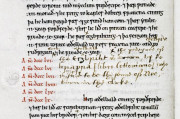Of the six manuscript versions of the Anglo-Saxon Chronicle, the Peterborough Chronicle, commonly cited as E, is the longest of the extant copies. Created and maintained by Peterborough’s monastic community, it contains some of the only contemporary first-hand reports of post-Conquest England. The early parts of the manuscript were lost in a fire of 1116 and so were recopied, however the records from 1070 to the last entries for the year 1155 capture the events through eyewitness accounts of the English civil war of succession called the Anarchy.
The only original decoration is the ornamented initial on fol. 1r, a green B outlined and embellished with red. It has similarity to another manuscript produced at Peterborough, strengthening its origin in East Anglia. The records and observations include the plight of the ordinary people in the north of England rather than strictly courtly or ecclesiastical affairs. A second chronicle was added in the thirteenth century as marginal text in Anglo-Norman French. Due to its continuation into the twelfth century, it captures details of social and linguistic changes in post-Conquest England.
Longest Version of the Anglo-Saxon Chronicle
Of the nine surviving copies and fragments of the Anglo-Saxon Chronicle, the Peterborough copy, referred to as the E manuscript, has three distinct parts. The pre-1122 records were damaged in a fire and so the present text is a copy of Winchester’s version.
The post-1122 portions are divided into First (1122–1131) and Second (1132–1154) continuations. These represent the longest-running records for any of the Chronicles and they provide a wealth of information about a tumultuous time in English history and language.
Captures Transition from Old to Middle English
Due to the nature of keeping a chronicle, the manuscript was added to over a period of at least thirty years during a time in which the English language underwent the transition from Old to Middle English.
This transition is remarkably preserved in the Peterborough Chronicle by virtue of its continuation into the twelfth century and provides invaluable insight into the process of linguistic change. It also contains the first known written record of the feminine pronoun “she” (scæ).
Four Centuries of Scholarship
Due to the Peterborough Chronicle’s important place in the study of the English language, it has been the focus of scholarship since the sixteenth century. William Cecil, Lord Burghleigh owned the manuscript in the sixteenth century from which Laurence Nowell made a transcription, now London, British Library, Add. 43704.
It was studied by Matthew Parker in 1566/67, who added underlinings, scoring in the margin, and pointing fingers. Acquired by Laud in 1636 from the Early English scholar, William L'Isle, whose notes appear on the interleaved paper. It was bequeathed by him to Oxford University in 1639.
Binding description
The cover is blind-tooled leather with a central heraldic shield of the arms of the Archbishop of Canterbury in metal. It certainly dates to the mid-seventeenth century per the note at the bottom of fol. 1r added when William Laud took possession of it in 1638.
We have 1 facsimile edition of the manuscript "Peterborough Chronicle": The Peterborough Chronicle facsimile edition, published by Rosenkilde and Bagger, 1954
Request Info / Price






